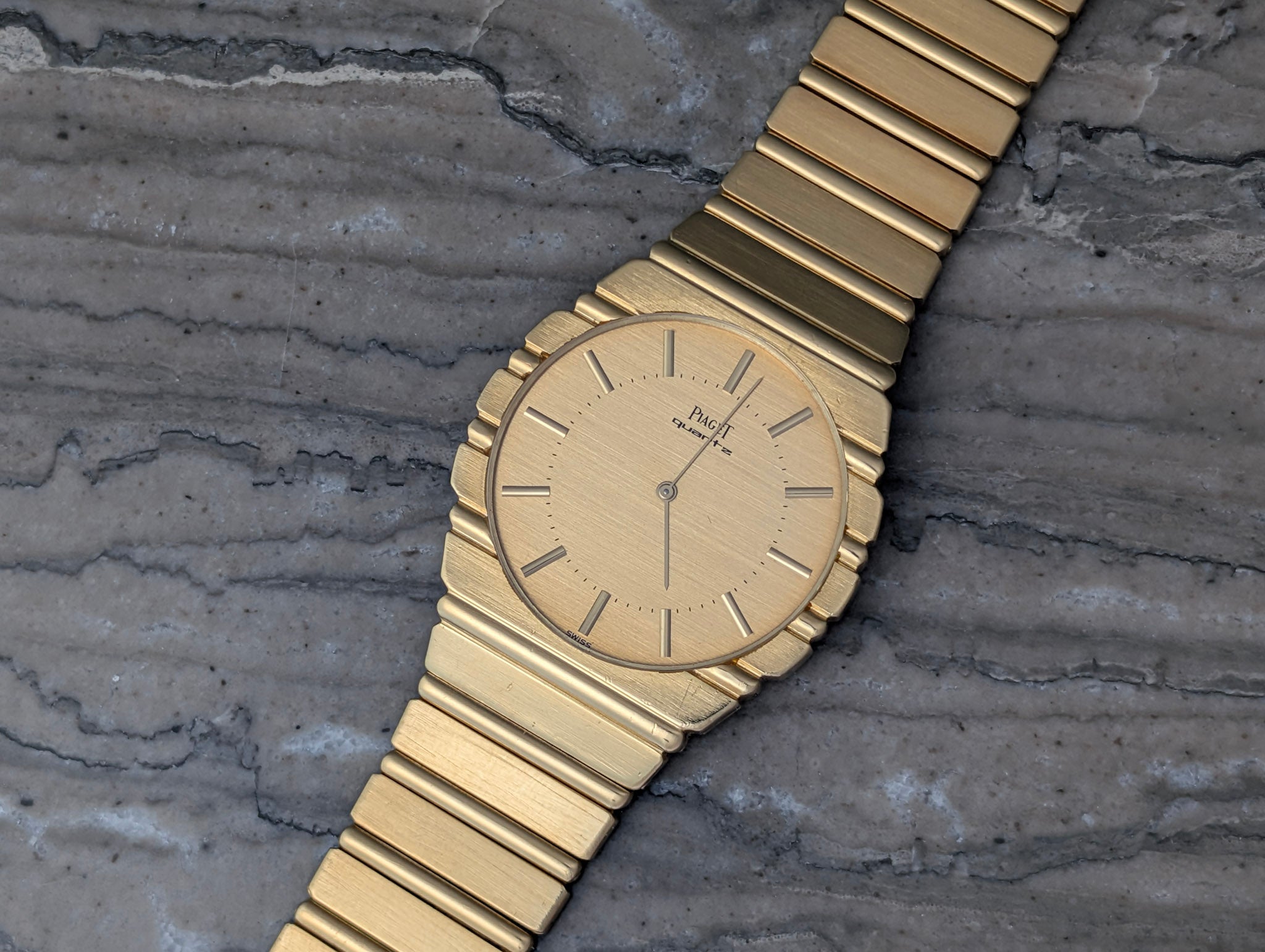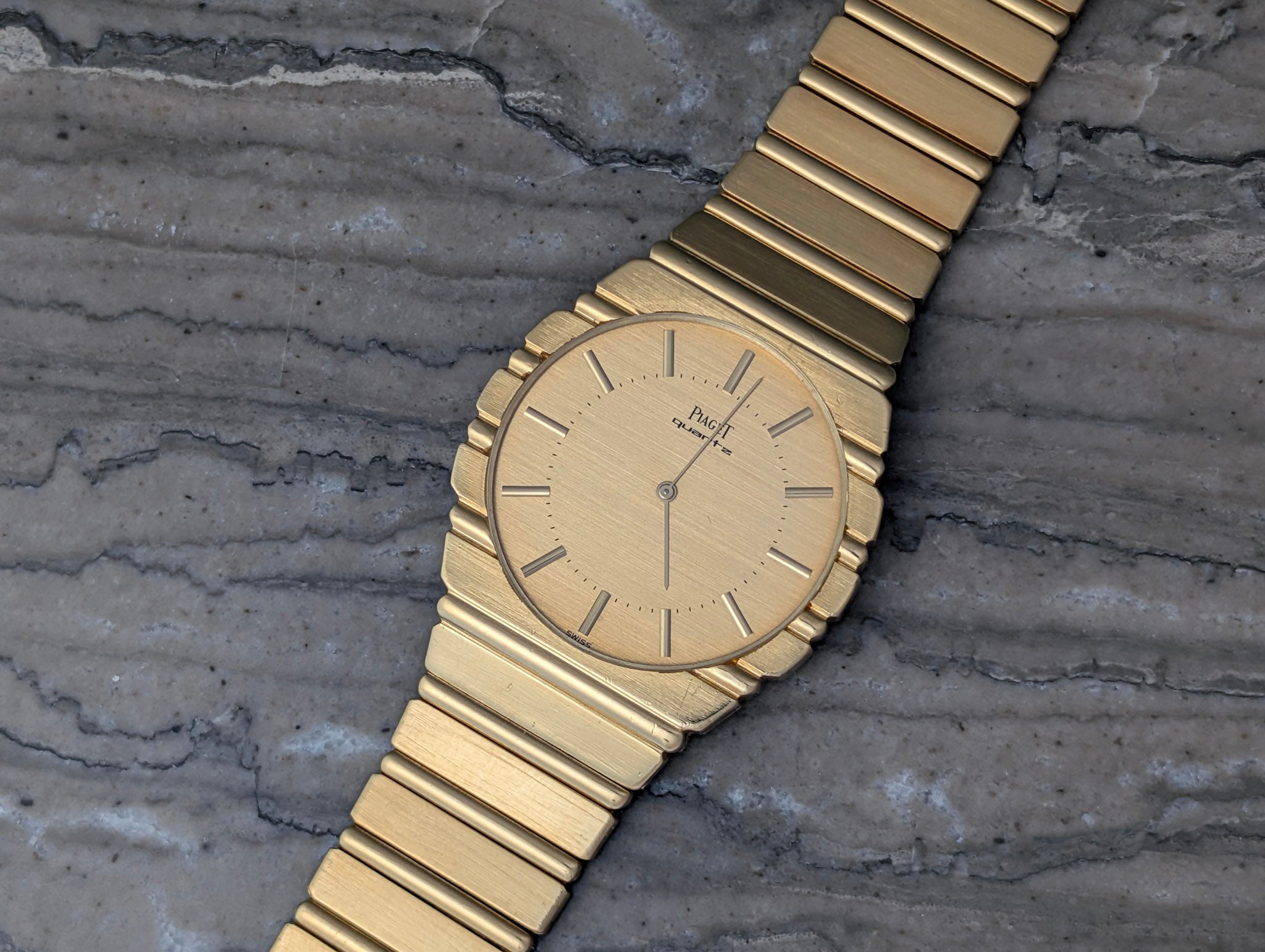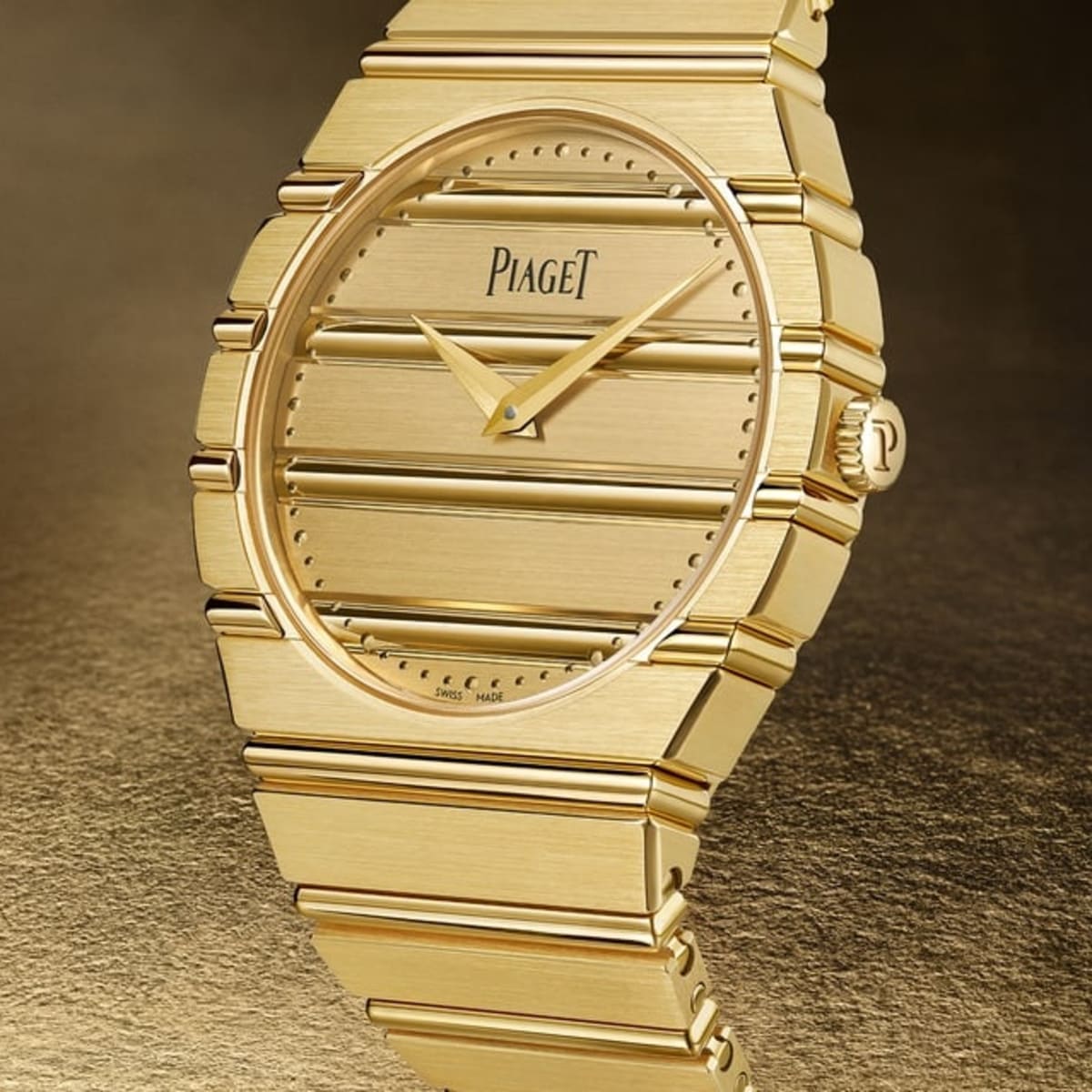
Piaget Polo Revival the ultimate guide to the Polo 79
Piaget Polo: From 1979 Debut to the 2024 ‘Polo ’79’ Revival – Evolution of a Sport-Chic Icon
The Piaget Polo is an iconic luxury sports watch that has captivated collectors since its launch in 1979. Blending the refinement of high jewelry with serious watchmaking, the Polo line introduced a new “sport-chic” elegance to Piaget’s collectionpiaget.com. From its origins as a jet-set status symbol of the 1980s to the modern revival piece in 2024, the Piaget Polo’s evolution reflects a balance of glamour, innovation, and timeless style. In this editorial, we trace the Polo’s history and design language, highlight the new Piaget Polo ’79 reissue (ref. 7661 C 701), and provide a guide to the current Piaget Polo lineup – including automatic, chronograph, skeleton, and high-jewelry versions – for collectors and prospective buyers.
The 1979 Debut: Birth of a Luxury Sport-Chic Watch

In 1979, Piaget unveiled the Piaget Polo, the Maison’s first “sports elegant” watchpiaget.com. It arrived in the wake of other 1970s luxury sports watches (like the AP Royal Oak of 1972 and Patek Nautilus of 1976), yet Piaget took a very different approach. While other brands crafted their sport watches in steel, Piaget stayed true to its heritage of precious metals, constructing the Polo entirely in 18k goldthehourmarkers.comswisswatches-magazine.com. The result was a bold, flamboyant statement piece that defined the spirit and glamour of the era. Piaget conceived the Polo as a “watch bracelet rather than a mere wristwatch,” as Yves G. Piaget famously remarkedthehourmarkers.com. In other words, the watch was designed as jewelry first – a seamless gold bracelet that just happened to tell time – embodying casual elegance and sporty sophistication in equal measure.
Upon its debut, the Piaget Polo quickly became a symbol of luxury and sport-chic elegance. Its name evoked the aristocratic sport of polo, and the watch was equally at home at Palm Beach polo matches as it was under the lights of New York’s Studio 54 nightclubwatchcollectinglifestyle.com. Backed by Yves Piaget’s friendships in the worlds of film, art, and sports, the Polo was adopted by the era’s glitteratiharpersbazaar.com.au. In fact, it became a status symbol almost overnightharpersbazaar.com.au. Legendary artist Andy Warhol owned two Piaget Polos and wore them during his famous nights out, and the model graced the wrists of celebrities ranging from tennis star Björn Borg to actors Roger Moore and Ursula Andress, comedian Steve Martin, and jazz icon Miles Davisharpersbazaar.com.au. Such high-profile visibility cemented the Polo’s reputation and tied it to the exclusive “Piaget Society” lifestyle of late-70s high societywatchcollectinglifestyle.compiaget.com.
A Design Language Blending Jewelry and Horology
The Piaget Polo’s design in 1979 was unlike anything else in watchmaking at the time. It perfected the genre of integrated bracelet sports watches with an unbroken visual flow from case to bracelet to dialwatchcollectinglifestyle.comthehourmarkers.com. The entire watch appeared sculpted from a single block of gold. Its defining aesthetic feature was the use of alternating polished and brushed horizontal grooves – known as gadroons – across the dial and bracelet linkshodinkee.com. These bold gold stripes gave the Polo a distinctive texture and shimmer, creating a seamless, sculptural look. Nowhere in the integrated-bracelet genre was the integration as continual as on the Polo, thanks to this gadroon motif and Piaget’s jeweler-like metalworkthehourmarkers.com. The craftsmanship was so fine that the bracelet draped around the wrist like a second skinwatchcollectinglifestyle.com. Advertised as “the world’s ultimate sports watch” in its day, the Polo proved that a watch could be both robust and opulent at oncewatchcollectinglifestyle.com.
Under the hood, Piaget also demonstrated horological innovation. Unconventionally for a high-end watch, the original Polo of 1979 was powered by a quartz movement – Piaget’s in-house caliber 7P – at a time when Swiss makers feared quartz technologyhodinkee.comtimeandtidewatches.com. Yves Piaget deliberately embraced quartz for the Polo to ensure precision and reliability in an active setting, noting that a quartz caliber could keep more accurate time under the shocks of sport than a mechanical movementtimeandtidewatches.com. The 7P was ultra-thin (the world’s smallest quartz movement at the time) and fit elegantly into the slim gold casethehourmarkers.com. This technical choice, paired with Piaget’s legendary ultra-thin watchmaking expertise, meant the Polo was as functional as it was fashionable. It was water-resistant and shock-resistant enough for an active lifestyle, yet it “refused to compromise on luxury and exclusivity”, as Piaget only used precious metals and gemstones in that erawatchcollectinglifestyle.com. In essence, the Piaget Polo married jewelry-level luxury with cutting-edge watch engineering, encapsulating the “casual chic” trend that was taking hold in late 20th-century luxuryswisswatches-magazine.com.
The 2024 Revival: Piaget Polo ’79 Reissue (Ref. 7661 C 701)

Fast forward 45 years, and Piaget has paid tribute to this heritage with the release of the Piaget Polo ’79 in 2024. This modern reissue – reference 7661 C 701 – revives the look and feel of the original 1979 model while updating it for contemporary collectors. Piaget Polo ’79 is a 38mm “brick” of 18k yellow gold, with a case and bracelet that remain faithfully integratedhodinkee.com. In fact, nearly 200 grams of gold are used in the watch’s construction, echoing the extravagant all-gold allure of the originalhodinkee.com. The signature design elements return: the dial, bezel, and bracelet are unified by the gadroons – those horizontal polished gold bars interrupting satin-brushed gold surfaceshodinkee.com. Just as in 1979, the dial is minimalist with no seconds hand, featuring only elegant gold hour and minute hands and the vintage “Piaget” logo at 12 o’clockhodinkee.com. The bracelet links taper smoothly to a hidden folding clasp, so the pattern of the gadroons is uninterrupted around the wristhodinkee.com. In terms of aesthetics, the Polo ’79 is a faithful homage to the original “watch bracelet” concept, bringing Yves Piaget’s vision into the modern erahodinkee.com.
Beyond its look, the 2024 Polo ’79 incorporates important technical evolutions. Notably, it trades the quartz movement of the old model for a finely crafted mechanical caliber. Inside beats Piaget’s ultra-thin caliber 1200P1, a micro-rotor automatic movement measuring only 2.35mm thickhodinkee.comhodinkee.com. This caliber (derived from Piaget’s renowned Altiplano ultra-thin movements) runs at 21,600 vph and offers a 44-hour power reservehodinkee.com. Thanks to this modern movement, the new Polo ’79 combines Piaget’s two greatest watchmaking contributions – the elegant gold bracelet watch and the ultra-thin mechanical watch – in one packagehodinkee.com. The case of the reissue is slightly larger and thicker to accommodate the automatic movement (38mm diameter and 7.35mm thick, versus 34mm and an even slimmer profile for the 1979 version)hodinkee.comwatchcollectinglifestyle.com. Even so, it remains impressively svelte on the wrist and retains a flat sapphire crystal and 50 meters of water resistance for everyday durabilityhodinkee.com. The emphasis is still on slim, sleek wearability – now achieved through mechanical finesse rather than quartz. Piaget wisely kept the Polo ’79 true to its roots: it is rendered only in yellow gold and carries an almost identical look to its predecessor, right down to the two-line dial and polished gold accents, but with the benefits of a modern movement and fabrication quality.
Importantly, the Piaget Polo ’79 reissue is not a limited edition gimmick but a regular (if limited-production) offering in Piaget’s collectionhodinkee.com. With a price around $73,000 USDhodinkee.com, it targets dedicated enthusiasts of Piaget and 1980s design. This revival piece shows Piaget “bringing the Polo back” with authenticity – a move that many collectors had been hoping forhodinkee.comhodinkee.com. By reissuing the Polo in such faithful form, Piaget has acknowledged the enduring appeal of the original model and its importance in the brand’s history. The Polo ’79 (7661 C 701) stands as both a nostalgic tribute and a luxurious modern timepiece, bridging the past and present of sport-luxe watch design.
1979 vs. 2024: Continuity and Evolution
The original 1979 Piaget Polo (left) and the modern 2024 Piaget Polo ’79 reissue (right) share the iconic integrated 18k gold design with horizontal gadroons. The new model stays remarkably true to the original’s look, while being slightly larger to house a contemporary ultra-thin automatic movementhodinkee.comwatchcollectinglifestyle.com.
Despite a 45-year gap, the continuity between the 1979 Polo and the 2024 Polo ’79 is striking. Both watches feature the unmistakable DNA of the Polo line: an elegant rounded case fused with a gold link bracelet, a ridged gold dial with no numerals, and a minimalist two-hand display. The visual effect of the horizontal gold bars across the entire watch is essentially the same in both generationshodinkee.com. Anyone familiar with the vintage Polo would instantly recognize the reissue – at a glance, it truly looks like the 1979 design, polished up for today. This fidelity is a testament to the timelessness of Yves Piaget’s original idea.
However, there are subtle evolutions that bring the Polo ’79 into modern context. The most significant change is the movement technology. The 1979 Polo (ref. 7661 C701) was powered by a battery-operated 7P quartz caliber, which in the late ’70s was cutting-edge for thin precision timekeepinghodinkee.comtimeandtidewatches.com. In contrast, the 2024 Polo ’79 contains a mechanical automatic movement (cal. 1200P1), reflecting today’s preference among collectors for traditional mechanical haute horlogeriehodinkee.comhodinkee.com. Piaget thus went from embracing the future of quartz in 1979 to showcasing its mastery of ultra-thin mechanicals in 2024 – a shift that illustrates how the definition of “luxury watch” has evolved. Interestingly, this change means the new Polo is a tad thicker than the ultra-slim original; yet at ~7.4mm, it remains exceptionally thin for an automatic sport watchhodinkee.com.
Another evolution is size. The original men’s Polo measured about 34mm in diameter (there was also a smaller ~27mm version for women), which was in line with late-70s tasteshodinkee.com. The Polo ’79 reissue enlarges the case to 38mmwatchcollectinglifestyle.com – still modest by modern standards, but providing a bit more presence and wearability for today’s preferences. This size increase, along with the addition of a sapphire caseback window (to view the micro-rotor movement) in some versions, makes the new watch feel more contemporary without disrupting the proportions too much. Notably, the 2024 model also has a more pronounced crown at 3 o’clock for winding and setting (the original’s crown was fairly flush and often barely noticeable)
. Small adjustments in manufacturing, like improved water resistance seals and a sturdier deployant clasp, also upgrade the Polo for practical use todayhodinkee.comhodinkee.com.
Crucially, what has not changed is the Polo’s ethos. Both the 1979 and 2024 versions embody that unique Piaget philosophy of a watch that is equal parts luxury accessory and functional timer. Yves Piaget intended the Polo to be “robust enough to serve its purpose, [yet] handsome enough to be the talk of Studio 54”timeandtidewatches.com – essentially, a watch you could wear on the polo field in the afternoon and to a glamorous party at night. The new Polo ’79 carries the same spirit. It is still a solid gold statement of extravagance and style, yet built with the durability and precision to be worn daily. In both incarnations, the Piaget Polo stands out as an ultimate expression of sport-meets-chic. The successful continuity between the two models underscores the design’s timeless appeal and why the Polo remains a coveted icon among luxury sports watches.
Guide to the Modern Piaget Polo Lineup: Automatic, Chronograph, Skeleton & High-Jewelry
With the Polo ’79 reissue reminding enthusiasts of the collection’s roots, Piaget’s current Polo lineup offers a range of models that cater to modern tastes. Over the years, Piaget has expanded the Polo family beyond the original formula, introducing new materials, complications, and artistic editions – all while maintaining the Polo’s core identity of refined sporty elegance. Today, Piaget offers numerous steel Polo models alongside diamond-studded, skeletonized, and precious metal versionsswisswatches-magazine.com. Here’s a concise guide to the key variants available to collectors and buyers:
-
Piaget Polo Automatic (Three-Hand & Date): The contemporary descendant of the classic Polo is often referred to as the Piaget Polo S (introduced in 2016) in its steel iteration. These are 41–42mm automatic watches featuring the signature cushion-shaped dial within a round bezel and an integrated bracelet. The dial typically bears horizontal guilloché stripes as a nod to the original gadroon motif, and includes a date window, bringing practical everyday functionality. Powered by Piaget’s in-house automatic movements (such as the caliber 1110P), the Polo automatic models are versatile luxury sports watches for daily wear. They come in stainless steel for a modern casual look, but are also offered in rose or white gold for those who desire more opulence. With their blend of toughness and elegance, the automatic Polo watches appeal to those seeking a “go-anywhere, do-anything” timepiece with Piaget’s distinctive style.
-
Piaget Polo Chronograph: For buyers who want extra sportiness and functionality, Piaget offers chronograph versions of the Polo. These models typically feature a slightly thicker case (to accommodate the chronograph mechanism) and sub-dials on the face for timing seconds, minutes, and hours. Available largely in stainless steel – often with eye-catching blue or gray dials – the Polo Chronograph combines the collection’s dressy aesthetic with true sporting utility. It’s powered by Piaget’s integrated chronograph caliber (the 1160P automatic, derived from Piaget’s ultra-thin chrono architecture). The design retains the cushion-dial and integrated bracelet of the three-hand models, with pump-style pushers subtly protruding from the case. A Polo Chronograph is ideal for those who appreciate the luxury sports watch genre but also desire the technical charm of a chronograph complication, all wrapped in Piaget’s elegant execution.
-
Piaget Polo Skeleton: Showcasing Piaget’s high watchmaking artistry, the Polo Skeleton models take the idea of ultra-thin sports watch to the next level. Introduced in recent years, the Polo Skeleton features a 42mm case reduced to an astonishingly slim profile (around 6.5mm thick)revolutionwatch.com. The dial is entirely openworked – essentially, there is no dial plate, and instead the finely skeletonized movement bridges form the visual center of the watch. These models use Piaget’s calibre 1200S, a skeletonized version of its legendary ultra-thin automatic movement, allowing the wearer to admire the gears, wheels, and even the micro-rotor in motion through both the front and back of the watch. Polo Skeleton pieces come in stainless steel (often with a modern blue or slate gray finish on the movement) and even in high-tech black ceramic for a contemporary lookmonochrome-watches.com. Despite their delicate appearance, they maintain 30–50m water resistance and the Polo’s sporty intent. A skeletonized Polo appeals to collectors who value mechanical craftsmanship and visual drama – it’s a true conversation piece that merges Piaget’s ultra-thin innovation with the Polo’s sporty DNA.
-
Piaget Polo High-Jewelry Editions: In line with Piaget’s dual identity as jeweler and watchmaker, the Polo collection also includes dazzling high-jewelry interpretations. These range from diamond-encrusted bezel variants of the 42mm men’s models to fully gem-paved creations, as well as elegant 36mm ladies’ Polo watches with significant gemstone embellishment. For example, Piaget offers a Polo with a 36mm white gold case where the bezel is set with brilliant-cut diamonds and the entire dial is paved with diamonds – turning the watch into a sparkling jewel while still keeping its sporty-casual rootspiaget.com. There are even skeleton models set with dozens of baguette diamonds and colored sapphires, showcasing Piaget’s gem-setting prowess alongside the openworked movementpiaget.watchonista.com. These High-Jewelry Polo editions are the ultimate expression of the Polo’s original ethos as a “watch bracelet.” They trade a bit of everyday practicality for red-carpet glamour, appealing to connoisseurs who want their luxury sports watch to literally shine. Despite the lavish adornment, they remain functional Piaget timepieces at heart – often still powered by the same automatic calibers – proving that the worlds of haute joaillerie and horology can coalesce in one show-stopping watch.
Each of these Polo variants carries a piece of the original 1979 Polo’s legacy, whether it’s the seamless case/bracelet integration, the balanced sport-elegant styling, or Piaget’s technical know-how. The Piaget Polo Date and Chronograph models serve as versatile sporty companions, the Polo Skeleton highlights watchmaking finesse, and the Polo High-Jewelry pieces underscore Piaget’s glamorous heritage. This diverse lineup means there is a Piaget Polo for every kind of collector – from the purist seeking a vintage-inspired icon, to the enthusiast chasing modern complications, to the aesthete drawn to artistic craftsmanship.
Conclusion: Timeless Sporty Elegance Lives On
Over four decades after its debut, the Piaget Polo continues to stand out in the realm of luxury sports watches as a symbol of timeless sporty elegance and extravagance. Its journey from the bold 1979 original, through various evolutions, to the faithful 2024 Polo ’79 reissue, showcases Piaget’s commitment to honoring its heritage while innovating for the future. The Polo’s unique blend of jewelry-like design and serious watchmaking has earned it a special place in watch history – it helped define the sport-chic genre in the 1980s and remains just as relevant today for a new generation of watch lovers. Whether one is drawn to the nostalgia of the gold Polo ’79 reissue or to the modern steel and skeleton models, the Piaget Polo offers a distinctive take on the luxury sports watch: one that embodies both the casual sophistication of a sport watch and the lavish refinement of high jewelrypiaget.com. For collectors and prospective buyers, the Polo line represents an opportunity to wear a piece of Piaget’s storied legacy – a watch that truly captures “the instinct of distinction” and the joyful, jet-set elegance of the Piaget lifestyle, then and now.



